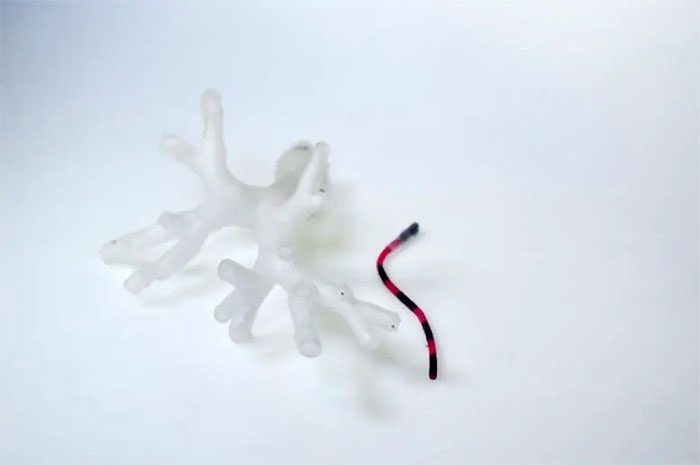Researchers from the University of Leeds in the UK have successfully developed a miniature robot that can penetrate deep into the lungs to detect and treat cancer, while also being capable of performing surgeries on brain tumors.
According to Scitech Daily, referencing a scientific report published on July 27 in the journal Nature Engineering Communications, this soft robotic tentacle was developed by engineers, scientists, and clinical doctors from the STORM Lab at the University of Leeds.
The ultra-soft robot, which has a diameter of only 2 mm and is controlled by magnets, can reach some of the smallest bronchial tubes and change the way lung cancer is treated. This technology opens up a new avenue for precise, suitable, and less invasive treatments.
Simulation of navigation and positioning of the tentacle robot in virtual lungs using magnetic control. (Video: STORM Lab, University of Leeds. Exceptional precision, reduced tissue damage).
Exceptional Precision, Reduced Tissue Damage
The researchers tested the magnetic tentacle robot on the lungs of a cadaver, finding that it could move 37% deeper than standard devices without causing significant tissue damage.
Professor Pietro Valdastri, Director of the STORM Lab and supervisor of the research project, stated: “This is a truly impressive development. This new approach has the advantage of replacing traditional surgery, is softer than surgery, and allows full control of the robot’s journey via magnetic means. These three main features could revolutionize the navigation capabilities of micro-devices within the body.”

Close-up of simulated lung tissue and the magnetic tentacle robot. (Photo: STORM Lab, University of Leeds Tackling the challenges of lung cancer surgery.)
Tackling the Challenges of Lung Cancer Surgery
Lung cancer has the highest cancer-related mortality rate worldwide. In early-stage non-small cell lung cancer, which accounts for about 84% of cases, surgical intervention is the only standard treatment. However, this method often requires highly invasive surgery and the removal of large amounts of lung tissue. The current approach is not suitable for all patients and severely affects lung function.
Screening programs for lung cancer have improved survival rates but also highlight the urgent need for non-invasive methods to diagnose and treat cancer early in patients.
The Future of Biopsies and Treatment Methods
Magnetically controlled tentacle robot technology enhances navigation capability within the lungs during biopsy procedures and could pave the way for less invasive treatment methods, allowing clinical doctors to target harmful cells while preserving the normal functioning of healthy tissues and organs.
Co-author of the scientific report, Dr. Giovanni Pittiglio, who conducted the research while pursuing his Ph.D. in Philosophy at the School of Electrical and Electronic Engineering at the University of Leeds, added: “Our goal is to provide a treatment support method with minimal pain for patients.”
“Remote magnetic actuation allows doctors to diagnose diseases using ultra-soft tentacle robots that can penetrate deeper, shaping surgical procedures and reducing trauma,” he stated.
The research team is currently gathering all necessary data to enable scientists to apply for permission to begin trials on human patients.

Demonstration simulation of the first use of two magnetically controlled soft robots for anterior brain surgery. (Photo: STORM Lab, University of Leeds. Coordinating magnetic tentacle robots in brain surgery).
Coordinating Magnetic Tentacle Robots in Brain Surgery
Researchers at the STORM Lab are also studying methods to control two independent magnetic robots that can coordinate operations in a limited area of the human body, allowing one robot to move a camera while the other directs a laser to remove a tumor.
The magnetically controlled robotic devices, constructed from silicone to minimize tissue damage, are operated by magnets attached to the robot arms outside the patient’s body.
Using a replica of the skull, the research team successfully tested the use of two robots to perform endoscopic brain surgery, a technique that allows surgeons to access areas at the front of the brain and the top of the spine through the nasal passage.
The researchers controlled the magnetic robots to move independently so that one robot moved the camera while the other directed the laser at the tumor.
Addressing Magnetic Interference When Controlling Two Robots
Typically, two permanent magnets placed near each other will attract each other, presenting challenges for the researchers’ control methods. The team tackled this challenge by designing the bodies of the tentacle robots to bend only in specific directions and changing the north and south poles in each magnetic tentacle robot.
In their experimental study, the scientists simulated the removal of a benign tumor from the pituitary gland at the base of the skull, successfully demonstrating the ability to control two robots within a limited area of the body for the first time.
This research project is co-funded by the European Research Council and the Physical Sciences Research Council, and was published on July 27 in the journal Advanced Intelligent Systems.
The lead author of the scientific paper, Zaneta Koszowska, a researcher at the School of Electrical and Electronic Engineering at the University of Leeds, stated: “This is an important contribution to the field of magnetically controlled robotics. Our inventions allow for diagnostic procedures using cameras and endoscopic surgery to be performed in small anatomical spaces.”



















































